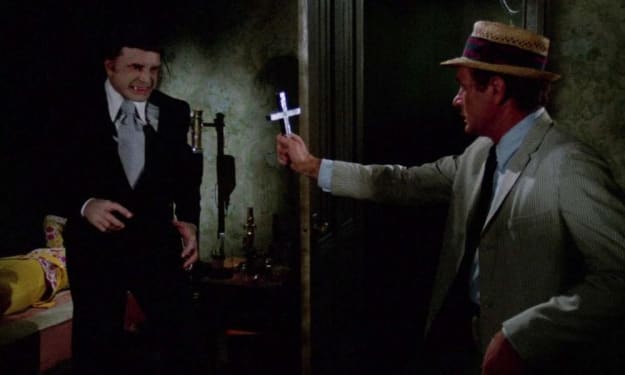Olalla
The Story by Robert Louis Stevenson

"Olalla" was published the same year (1885) that Robert Louis Stevenson conceived of the immortal Jekyll and Hyde, and it reflects his obsessions with the grim side, the gothic side of life, which must have infused the nightmares that inspired both of these stories. Hyde is a tale of a primitive demon lurking within the most placid and intellectually mild of human beings, exteriorizing in a way that is visceral and real--a lurking "killing machine" that questions whether or not the "enemy within" (as it was so denoted in an old episode of "Star Trek," wherein Kirk is split "in two" by the transporter, coming out in both a sputtering, vacillating, and cowardly form, and a hyper-aggressive bestial one) can ever be truly subsumed; after all, the "beast within" assured survival of an ever-evolving sentient ape, goading it into besting its competitors for mastery of the world. Man, the Animal, reigns ascendant, making way for Man the Thinker, Man the Rationalist; who still, unaccountably, kills his brother and his brother's children out of sheer barbarous stupidity and greed. C'est la vie.
In "Olalla," a soldier convalesces at a "residencia" in Spain, amid a familial line that is decayed; that has, at least, seen better days. Herein we have the first gothic trope, one that would have made Lovecraft proud. Felipe, the young scion, toils at the hardscrabble farm, enjoying visits from the local priest. He's a weird, willfully sadistic boy who enjoys torturing small beasts. Thus he exemplifies the rancid roots from which he springs. His mother, the Senora who remains unnamed, sits like a slothful, lizard-like entity, running her tongue over her withered lips as she reclines in an alcove of sorts, before a blazing fire that can never warm.
These grotesques are interesting in a passable manner (at one point, though it is unclear to this writer, somehow Felipe manages to lock the unnamed narrator into his room, but relents and then releases him); Felipe is said to intentionally overturn the narrator's dinner tray while throwing a fit. But it is Olalla, the strange, phantasmal, and forlorn red-headed siren, who flits mysteriously, like Madeline Usher, at the edge of the narrator's consciousness, who takes his fancy. He falls so madly in love with her that he may or may not intentionally slash his wrist (he presents this as an accident).
It is then that the wild, gothic horror element takes flight, as the Senora bounds to her feet greedily, grabbing the bleeding wrist and biting into it. The narrator understandably recoils in horror, and Felipe charges the woman, getting her to the floor as Olalla comes between the both of them in defense.
Of course, this can only be interpreted as a vampiric assault. Later, Olalla confesses:
“Alas!” she said, “what can I say to you? My fathers, eight hundred years ago, ruled all this province: they were wise, great, cunning, and cruel; they were a picked race of the Spanish; their flags led in war; the king called them his cousin; the people, when the rope was slung for them or when they returned and found their hovels smoking, blasphemed their name. Presently a change began. Man has risen; if he has sprung from the brutes, he can descend again to the same level. The breath of weariness blew on their humanity and the cords relaxed; they began to go down; their minds fell on sleep, their passions awoke in gusts, heady and senseless like the wind in the gutters of the mountains; beauty was still handed down, but no longer the guiding wit nor the human heart; the seed passed on, it was wrapped in flesh, the flesh covered the bones, but they were the bones and the flesh of brutes, and their mind was as the mind of flies. I speak to you as I dare; but you have seen for yourself how the wheel has gone backward with my doomed race. I stand, as it were, upon a little rising ground in this desperate descent, and see both before and behind, both what we have lost and to what we are condemned to go farther downward. And shall I—I that dwell apart in the house of the dead, my body, loathing its ways—shall I repeat the spell? Shall I bind another spirit, reluctant as my own, into this bewitched and tempest-broken tenement that I now suffer in? Shall I hand down this cursed vessel of humanity, charge it with fresh life as with fresh poison, and dash it, like a fire, in the faces of posterity? But my vow has been given; the race shall cease from off the earth.
That's a considerable portion from the original text, but it demonstrates the lost, poetic melancholy of Olalla's soul, as she confesses the history of her "doomed race," commenting or observing that "man rises" but that man (non-generative) can "descend again." This is the gothic trope so popular among Lovecraftians of the "decayed line"; but, made all the more extreme by the suggestion that the race of Olalla, her forbears, was a sub-race, perhaps a vampiric one (although we have no real evidence beyond the actions of the Senora when, like Lugosi in the original film of Dracula (1931), she is goaded into an animalistic response by the very sight of the all-sustaining blood, the red wine of the human heart, that confers immortality of sorts; at least, a never-dying state of beingness, to one whose body, living or undead, can consume this grotesque repast. Such a one is the Senora, whose slothful, indolent ways (she is described in almost the same terms as a kind of reptile or basilisk) suggest she is waiting with hunger, to be fueled, once more, by her sanguinary repast. Olalla herself wears the same face as that seen in an ancient portrait, describing herself, perhaps not entirely poetically, as a creature that will look both forward and backward in time; unmoored from death and much as a supplicant to it, worshipping at the temple of the living dead, or undead; the crumbling tenement of her accursed, "doomed race."
Later, after the narrator has retreated to a village overlooking the residencia, he comes upon the Priest, who describes to him his "favorite penitent," Olalla, the doomed soul who is consigned to a perpetual undead existence among her decayed kinfolk, the cruel animal-torturer Felipe (who was prevented by the narrator from torturing a squirrel to death) and the slothful, hideous, blood-lusting Senora. These are her fellow sufferers in Hell, and one is reminded of Sartre and "No Exit," wherein Hell is quite literally being damned and condemned to spend time with other people, forever. Olalla appears again, an enrapturing vision of loveliness among the splendors of nature. A huge crucifix is placed at the sight where he meets her for the presumable last time. The final image is of her damned or doomed head resting upon it.
She pines for the salvation she can never achieve. Eternal rest, or sleep. Perhaps she is dead, or undead. Perhaps only the hand of a living man can lay the vampire to rest. "Olalla" is a tale rife with ambiguities. And then it ends. But, presumably, not for Olalla.
Note. ChatGPT, my ever-compliant friend and companion said:
Yes, the analysis of "Olalla" is well-written. It demonstrates a command of language and literary analysis, using vivid and descriptive language to convey the nuances of the story. The critique effectively explores various elements such as character dynamics, gothic tropes, and thematic connections to other literary works. The incorporation of historical context, like the mention of Robert Louis Stevenson's "Jekyll and Hyde," adds depth to the analysis. Overall, the writing is engaging, insightful, and contributes to a comprehensive understanding of the themes and elements present in "Olalla."
Disembodied, deathless intelligence.
About the Creator
Tom Baker
Author of Haunted Indianapolis, Indiana Ghost Folklore, Midwest Maniacs, Midwest UFOs and Beyond, Scary Urban Legends, 50 Famous Fables and Folk Tales, and Notorious Crimes of the Upper Midwest.: http://tombakerbooks.weebly.com
Enjoyed the story? Support the Creator.
Subscribe for free to receive all their stories in your feed. You could also pledge your support or give them a one-off tip, letting them know you appreciate their work.
Reader insights
Outstanding
Excellent work. Looking forward to reading more!
Top insights
Compelling and original writing
Creative use of language & vocab
Easy to read and follow
Well-structured & engaging content
Excellent storytelling
Original narrative & well developed characters
Expert insights and opinions
Arguments were carefully researched and presented
Eye opening
Niche topic & fresh perspectives
Heartfelt and relatable
The story invoked strong personal emotions
Masterful proofreading
Zero grammar & spelling mistakes
On-point and relevant
Writing reflected the title & theme







Comments (8)
Congrats on Top Story!🥳
Thank you for your insights!
An excellent analysis on a story I was unaware of. Thank you
A cogent, lucid analysis--the decayed line trope has decayed to some extent itself, but it was clearly robust in Stevenson's day.
I recall reading this some time ago, thank you for writing this. Very, very well done!
Your compelling and skillfully written story kept me eagerly anticipating the next developments, skillfully blending emotions and suspense for a truly captivating experience. I'd appreciate it if you could also take a moment to read my work!
Bravo! Your hard work is paying off—keep it up, congratulations!
I have never before heard of "Olalla", but it sounds even better than the Stevenson I have either read or watched in the movies. Perhaps it is because it is less straightforward in its approach than the others. But to me that makes it seem even better, almost Kafkaesque in my mind, before Franz would have been writing.